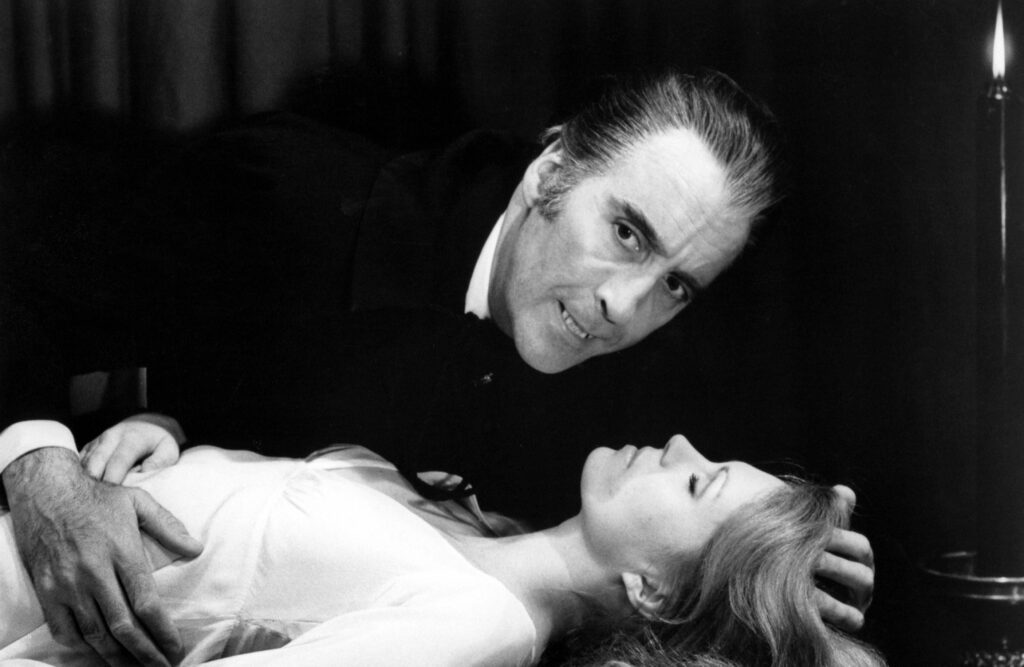Table of Contents
The Resurrection of Gothic Charm: A Review of “The Satanic Rites of Dracula”
Vampire movies are not new. Nosferatu was perhaps the first “vampire movie” from a still-infant movie industry. More recently, Twilight ran roughshod over the public youth’s collective imagination. The 1970s saw “The Satanic Rites of Dracula,” a Gothic relic from a time when the genre teetered between the traditional and the innovative. Released in 1974, this film – the swan song of Hammer’s Dracula series – presents a curious blend of horror, spy thriller, and a dash of science fiction that encapsulates the era’s experimental spirit.

The plot is an interesting marriage of occult and espionage. The narrative transports Count Dracula into the heart of 1970s London, where he masquerades as a business tycoon orchestrating a Satanic cult. His malevolent plan? To unleash a deadly virus that could wipe out humanity. The only obstacle in his path is the indefatigable Professor Van Helsing, played with venerable charisma by Peter Cushing. Their cat-and-mouse game is the lifeblood of the film, punctuated by moments of Gothic horror that harken back to the genre’s roots.
The film’s convolution reflects the complex paranoia of its time. Though predicting the future has long been the domain of science fiction, in this case of fantasy film, the plot is eerily prescient of more modern fears of bioterrorism and corporate overreach as seen through the movie’s scenes of clandestine meetings and diabolical science. It’s a cinematic concoction that brews up fear from the familiar and the futuristic.
What is truly commendable about “The Satanic Rites of Dracula” is its attempt to reinvent the Dracula mythos for a modern audience by tying together the Gothic background of the character and the rising fears of corporate overreach seen even in the 1970s. It’s a curious time capsule that reflects the era’s social anxieties through the lens of a Dracula narrative, enacted with a brooding intensity by Christopher Lee.
Moreover, the film’s exploration of satanic cults and the supernatural taps into the zeitgeist of the 70s, where interest in the occult surged. The inclusion of these elements adds a layer of cultural commentary to the film, suggesting a society grappling with the loss of traditional values amidst the rise of new, often disturbing, ideologies.
Director Alan Gibson crafts a visual style that is both nostalgic and avant-garde, and really brings to the screen the idiom of ‘what is old is new again’. The film’s aesthetic shifts between shadowy, fog-laden streets reminiscent of Victorian London and the sleek, sterile interiors of corporate power. This duality not only enriches the film’s visual palette but also mirrors the dual nature of Dracula himself. This was a time when special effects were still in their infancy, really, adn the director was reliant upon lighting, scene and plot to tell an intriguing story.
The film’s cinematography deserves special mention; the contrast between the dark, moody exteriors and the bright, modern interiors is not just visual but symbolic. The chiaroscuro (yes, I had to use a thesaurus to come up with that one) lighting, the strategic use of color and shadows, all serve to enhance the thematic tension between old-world horror and contemporary fears.
“The Satanic Rites of Dracula” is more than just a horror film; it’s a cultural touchstone that captures the spirit of an era. The movie’s attempt to contemporize the Dracula mythos serves as a fascinating study in how classic stories can be reimagined to reflect the anxieties and aesthetics of modern times. It encapsulates a moment in cinematic history where the lines between past and present, supernatural and science, began to blur intriguingly.
The film’s cultural commentary, though wrapped in the guise of a horror narrative, dissects the collective unease of its time. It paints a picture of a society at the crossroads of progress and decay, much like the gothic elements it so richly portrays.
In its own unique way, “The Satanic Rites of Dracula” comments on the idea of community and legacy. It shows how stories evolve over time, adapting to new eras while still retaining a core identity. This film acts as a cultural conduit, connecting audiences across different times through a shared mythology and demonstrating the enduring appeal of the Dracula legend.
The way the film intertwines themes of immortality and modernity resonates with the viewer’s sense of historical continuity. It reminds us that while forms and expressions may change, certain narratives remain timeless in their ability to engage and captivate.
While it may not stand at the forefront of cinematic achievements, “The Satanic Rites of Dracula” holds its ground as a distinctive piece of the horror film canon. It’s a film that invites audiences to revisit the genre’s roots while also appreciating the boldness of its thematic experimentation.
To the enthusiast of horror and cinema history, the film offers a unique lens through which to view the evolution of a genre. It stands as a testament to the adaptability of iconic tales and their power to continuously captivate and resonate with audiences through generations.
